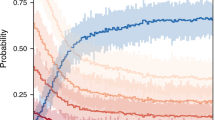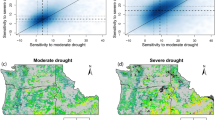Abstract
Widespread episodes of recent forest die-off have been tied to the occurrence of anomalously warm droughts, although the underlying mechanisms remain inadequately understood. California’s 2012–2015 drought, with exceptionally low precipitation and warmth, and widespread conifer death, provides an opportunity to explore the chain of events leading to forest die-off. Here, we present the spatial and temporal patterns of die-off and moisture deficit during California’s drought, based on field and remote sensing observations. We found that die-off was closely tied to multi-year deep-rooting-zone drying, and that this relationship provides a framework with which to diagnose and predict mortality. Marked tree death in an intensively studied Sierra Nevada forest followed a four-year moisture overdraft, with cumulative 2012–2015 evapotranspiration exceeding precipitation by ~1,500 mm, and subsurface moisture exhaustion to 5–15-m depth. Observations across the entire Sierra Nevada further linked tree death to deep drying, with die-off and moisture overdraft covarying across latitude and elevation. Unusually dense vegetation and warm temperatures accelerated southern Sierran evapotranspiration in 2012–2015, intensifying overdraft and compounding die-off by an estimated 55%. Climate change is expected to further amplify evapotranspiration and moisture overdraft during drought, potentially increasing Sierran tree death during drought by ~15–20% °C−1.
This is a preview of subscription content, access via your institution
Access options
Access Nature and 54 other Nature Portfolio journals
Get Nature+, our best-value online-access subscription
$29.99 / 30 days
cancel any time
Subscribe to this journal
Receive 12 print issues and online access
$259.00 per year
only $21.58 per issue
Buy this article
- Purchase on Springer Link
- Instant access to full article PDF
Prices may be subject to local taxes which are calculated during checkout




Similar content being viewed by others
Data availability
Data are available from UC Irvine Dash, https://doi.org/10.7280/D1DH3B.
References
Breshears, D. D. et al. Regional vegetation die-off in response to global-change-type drought. Proc. Natl Acad. Sci. USA 102, 15144–15148 (2005).
Van Mantgem, P. J. et al. Widespread increase of tree mortality rates in the western United States. Science 323, 521–524 (2009).
Allen, C. D. et al. A global overview of drought and heat-induced tree mortality reveals emerging climate change risks for forests. For. Ecol. Manag. 259, 660–684 (2010).
Fellows, A. W. & Goulden, M. L. Rapid vegetation redistribution in Southern California during the early 2000s drought. J. Geophys. Res. Biogeosci. 117, G03025 (2012).
Williams, A. P. et al. Temperature as a potent driver of regional forest drought stress and tree mortality. Nat. Clim. Change 3, 292–297 (2013).
Allen, C. D., Breshears, D. D. & McDowell, N. G. On underestimation of global vulnerability to tree mortality and forest die-off from hotter drought in the Anthropocene. Ecosphere 6, 1–55 (2015).
McDowell, N. et al. Mechanisms of plant survival and mortality during drought: why do some plants survive while others succumb to drought? New Phytol. 178, 719–739 (2008).
McDowell, N. G., Ryan, M. G., Zeppel, M. J. B. & Tissue, D. T. Improving our knowledge of drought-induced forest mortality through experiments, observations, and modeling. New Phytol. 200, 289–293 (2013).
Jump, A. S. et al. Structural overshoot of tree growth with climate variability and the global spectrum of drought-induced forest dieback. Glob. Change Biol. 23, 3742–3757 (2017).
Griffin, D. & Anchukaitis, K. J. How unusual is the 2012–2014 California drought? Geophys. Res. Lett. 41, 9017–9023 (2014).
Asner, G. P. et al. Progressive forest canopy water loss during the 2012–2015 California drought. Proc. Natl Acad. Sci. USA 113, E249–E255 (2016).
Williams, A. P. et al. Contribution of anthropogenic warming to California drought during 2012–2014. Geophys. Res. Lett. 42, 6819–6828 (2015).
Bales, R. C. et al. Mechanisms controlling the impact of multi-year drought on mountain hydrology. Sci. Rep. 8, 690 (2018).
Coleman, T. W. et al. Accuracy of aerial detection surveys for mapping insect and disease disturbances in the United States. For. Ecol. Manag. 430, 321–336 (2018).
Hardisky, M. A., Klemas, V. & Smart, R. M. The influence of soil-salinity, growth form, and leaf moisture on the spectral radiance of Spartina alterniflora canopies. Photogramm. Eng. Remote Sens. 49, 77–83 (1983).
Yilmaz, M. T., Hunt, E. R. & Jackson, T. J. Remote sensing of vegetation water content from equivalent water thickness using satellite imagery. Remote Sens. Environ. 112, 2514–2522 (2008).
Goodwin, N. R. et al. Estimation of insect infestation dynamics using a temporal sequence of Landsat data. Remote Sens. Environ. 112, 3680–3689 (2008).
Byer, S. & Jin, Y. F. Detecting drought-induced tree mortality in Sierra Nevada forests with time series of satellite. Data. Remote Sens. 9, 929 (2017).
Paz-Kagan, T. et al. What mediates tree mortality during drought in the southern Sierra Nevada? Ecol. Appl. 27, 2443–2457 (2017).
Goulden, M. L. et al. Evapotranspiration along an elevation gradient in California’s Sierra Nevada. J. Geophys. Res. Biogeosci. 117, G03028 (2012).
Goulden, M. L. & Bales, R. C. Mountain runoff vulnerability to increased evapotranspiration with vegetation expansion. Proc. Natl Acad. Sci. USA 111, 14071–14075 (2014).
Klos, P. Z. et al. Subsurface plant-accessible water in mountain ecosystems with a Mediterranean climate. Wiley Interdiscip. Rev. Water 5, e1277 (2018).
O’Geen, A. et al. Southern Sierra Critical Zone Observatory and Kings River Experimental Watersheds: a synthesis of measurements, new insights, and future directions. Vadose Zone J. 17, 180081 (2018).
Fellows, A. W. & Goulden, M. L. Mapping and understanding dry season soil water drawdown by California montane vegetation. Ecohydrology 10, e1772 (2017).
Schenk, H. J. & Jackson, R. B. Rooting depths, lateral root spreads and below-ground/above-ground allometries of plants in water-limited ecosystems. J. Ecol. 90, 480–494 (2002).
Anderegg, W. R. L. et al. Tree mortality from drought, insects, and their interactions in a changing climate. New Phytol. 208, 674–683 (2015).
Franklin, J. F., Shugart, H. H. & Harmon, M. E. Tree death as an ecological process. Bioscience 37, 550–556 (1987).
Daly, C. et al. Physiographically sensitive mapping of climatological temperature and precipitation across the conterminous United States. Int. J. Climatol. 28, 2031–2064 (2008).
Argus, D. F. et al. Sustained water loss in California’s mountain ranges during severe drought from 2012 to 2015 inferred from GPS. J. Geophys. Res. Solid Earth 122, 10559–10585 (2017).
Ferrell, G. T. in Sierra Nevada Ecosystem Project: Final Report to Congress, Vol. II. Assessments and Scientific Basis for Management Options 1177–1192 (University of California, Davis and Centers for Water and Wildlands Resources, 1996).
Kelly, A. & Goulden, M. Rapid shifts in plant distribution with recent climate change. Proc. Natl Acad. Sci. USA 105, 11823–11826 (2008).
Pierce, D. W. et al. Probabilistic estimates of future changes in California temperature and precipitation using statistical and dynamical downscaling. Clim. Dynam. 40, 839–856 (2013).
Swain, D. L., Langenbrunner, B., Neelin, J. D. & Hall, A. Increasing precipitation volatility in twenty-first-century California. Nat. Clim. Change 8, 427–433 (2018).
Berg, N. & Hall, A. Increased interannual precipitation extremes over California under climate change. J. Clim. 28, 6324–6334 (2015).
Trujillo, E., Molotch, N. P., Goulden, M. L., Kelly, A. E. & Bales, R. C. Elevation-dependent influence of snow accumulation on forest greening. Nat. Geosci. 5, 705–709 (2012).
Wilmers, C. C., Post, E. & Hastings, A. A perfect storm: the combined effects on population fluctuations of autocorrelated environmental noise, age structure, and density dependence. Am. Nat. 169, 673–683 (2007).
Deser, C., Phillips, A. S., Alexander, M. A. & Smoliak, B. V. Projecting North American climate over the next 50 years: uncertainty due to internal variability. J. Clim. 27, 2271–2296 (2014).
Thom, D. & Seidl, R. Natural disturbance impacts on ecosystem services and biodiversity in temperate and boreal forests. Biol. Rev. 91, 760–781 (2016).
Kelly, A. E. & Goulden, M. L. A montane Mediterranean climate supports year-round photosynthesis and high forest biomass. Tree Physiol. 36, 459–468 (2016).
Twine, T. E. et al. Correcting eddy-covariance flux underestimates over a grassland. Agric. For. Meteorol. 103, 279–300 (2000).
Grier, C. C. & Running, S. W. Leaf area of mature northwestern coniferous forests—relation to site water-balance. Ecology 58, 893–899 (1977).
Gholz, H. L. Environmental limits on above-ground net primary production, leaf-area, and biomass in vegetation zones of the Pacific Northwest. Ecology 63, 469–481 (1982).
Carlson, T. N. & Ripley, D. A. On the relation between NDVI, fractional vegetation cover, and leaf area index. Remote Sens. Environ. 62, 241–252 (1997).
Gamon, J. et al. Relationships between NDVI, canopy structure, and photosynthesis in 3 Californian vegetation types. Ecol. Appl. 5, 28–41 (1995).
Markham, B. L. & Helder, D. L. Forty-year calibrated record of Earth-reflected radiance from Landsat: a review. Remote Sens. Environ. 122, 30–40 (2012).
Masek, J. G. et al. A Landsat surface reflectance dataset for North America, 1990–2000. IEEE Geosci. Remote Sens. Lett. 3, 68–72 (2006).
Ju, J. C. & Masek, J. G. The vegetation greenness trend in Canada and US Alaska from 1984–2012 Landsat data. Remote Sens. Environ. 176, 1–16 (2016).
Sulla-Menashe, D., Fried, M. A. & Woodcock, C. E. Sources of bias and variability in long-term Landsat time series over Canadian boreal forests. Remote Sens. Environ. 177, 206–219 (2016).
Roy, D. P. et al. Characterization of Landsat-7 to Landsat-8 reflective wavelength and normalized difference vegetation index continuity. Remote Sens. Environ. 185, 57–70 (2016).
Zhu, Z. & Woodcock, C. E. Automated cloud, cloud shadow, and snow detection in multitemporal Landsat data: an algorithm designed specifically for monitoring land cover change. Remote Sens. Environ. 152, 217–234 (2014).
Zhang, H. K. & Roy, D. P. Landsat 5 Thematic Mapper reflectance and NDVI 27-year time series inconsistencies due to satellite orbit change. Remote Sens. Environ. 186, 217–233 (2016).
Brodrick, P. G., Anderegg, L. D. L. & Asner, G. P. Forest drought resistance at large geographic scales. Geophys. Res. Lett. 46, 2752–2760 (2019).
Acknowledgements
This research was supported by the US National Science Foundation, through the SSCZO (EAR-1331931), US Department of Agriculture (2018–67004–27405) and University of California Laboratory Fees Research Program. The eddy covariance sites were located at the San Joaquin Experimental Range, Kings River Experimental Watershed and Sierra National Forest in cooperation with the USFS.
Author information
Authors and Affiliations
Contributions
M.L.G. and R.C.B. designed the research. M.L.G. performed the research. M.L.G. analysed the data. M.L.G. and R.C.B. wrote the paper.
Corresponding author
Ethics declarations
Competing interests
The authors declare no competing interests.
Additional information
Publisher’s note: Springer Nature remains neutral with regard to jurisdictional claims in published maps and institutional affiliations.
Supplementary information
Supplementary Information
Supplementary Figs. 1–12
Rights and permissions
About this article
Cite this article
Goulden, M.L., Bales, R.C. California forest die-off linked to multi-year deep soil drying in 2012–2015 drought. Nat. Geosci. 12, 632–637 (2019). https://doi.org/10.1038/s41561-019-0388-5
Received:
Accepted:
Published:
Issue Date:
DOI: https://doi.org/10.1038/s41561-019-0388-5
This article is cited by
-
Integrating ecosystem water demands into drought monitoring and assessment under climate change
Nature Water (2024)
-
Increasing radial growth in old-growth high-elevation conifers in Southern California, USA, during the exceptional “hot drought” of 2000–2020
International Journal of Biometeorology (2024)
-
Fuels change quickly after California drought and bark beetle outbreaks with implications for potential fire behavior and emissions
Fire Ecology (2023)
-
Tree mortality during long-term droughts is lower in structurally complex forest stands
Nature Communications (2023)
-
A joint framework for studying compound ecoclimatic events
Nature Reviews Earth & Environment (2023)



